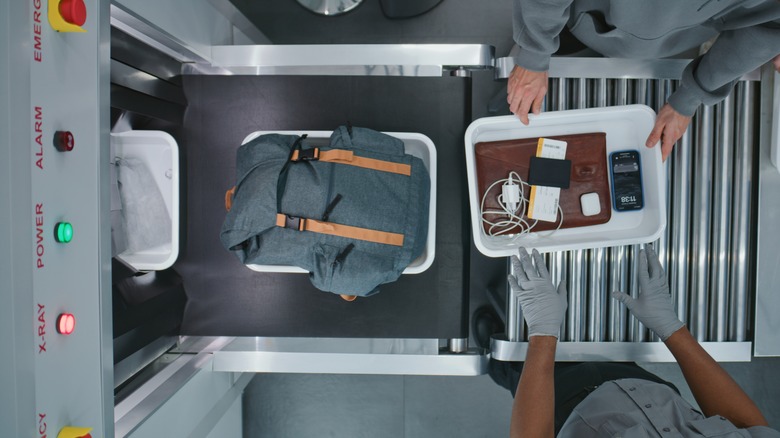The Bizarre Reason To Avoid Putting Cheese Through A TSA Scanner Even Though It's Legal
Dealing with airport security rules is enough to make your head spin. From taking off your shoes before going through the scanner to emptying out your pockets, sliding out of your coat, and separating your liquids and electronics into their own bin, the Transportation Security Administration (TSA) puts travelers through what feels like an obstacle course before boarding. Throw in the fact that simply being at the airport already comes with its own share of anxiety — with delayed flights, cramped seats, and crowded spaces — and you've got yourself a recipe for the highest levels of pre-travel stress.
So, with all these rules and procedures to remember, it makes sense that the innocent block of cheese tucked away in your carry-on might be the last thing on your mind when prepping for a TSA screening. However, while most cheese is completely legal to bring through security, there are still some exceptions you need to keep in mind. For one, spreadable cheeses and dips are considered a liquid by the TSA. This means that they must follow the agency's 3-1-1 liquids rule and be 3.4 ounces or less and placed in a single, clear, quart-sized bag.
That said, this distinction doesn't necessarily mean that your solid block of cheddar gets a free pass. In fact, depending on its size, it can cause even more issues due to its density. A density which, in the wrong circumstances, can actually show up suspiciously similar to certain explosives on an X-ray machine — essentially mimicking bomb components that are clearly banned at airports everywhere. To make matters worse, this resemblance can also quickly lead to additional screening — with TSA agents pulling you and your bag aside for closer inspection and potentially even swabbing your hands and your belongings for any explosive residue.
Other items that might look a little suspicious taking through TSA
Cheese isn't the only innocent snack that can trigger TSA alarms. Chocolate, especially in dense, brick-like form, can also lead to similar issues for travelers. Just like cheese, chocolate looks like a solid, organic mass on X-ray machines that can get mistaken for certain explosive materials that you wouldn't want to be carrying around at an airport. Beyond that, stacks of books and magazines can also raise flags during the TSA screening process. When packed tightly together, the paper density can lead to a suspicious image on the scanner, forcing agents to unpack them and fan through pages one-by-one to make sure there's nothing suspicious hiding inside.
But how come all of these items keep getting mistaken for something they're clearly not? Put simply, these false alarms happen because bomb detection equipment is designed to identify organic materials with specific densities (drugs and explosives). Unfortunately, though, plenty of other everyday items can also fall into this category. This is something that becomes even more complicated when you consider that how they're packed is just as important as what they are. For example, a block of cheese that's inadvertently sitting next to a cell phone charger or electronic device might look very similar to an improvised explosive device — and send the entire security checkpoint into a frenzy.
That said, if you're hoping to get through airport without getting flagged by the TSA, the easiest way is to let the agent know beforehand that you're carrying cheese or chocolate in your suitcase, not a massive explosive. Ideally, you'll also want to make sure they're easily reachable in your bag — not buried at the bottom of dirty clothes and toiletries — just in case officers need to take a closer look.

